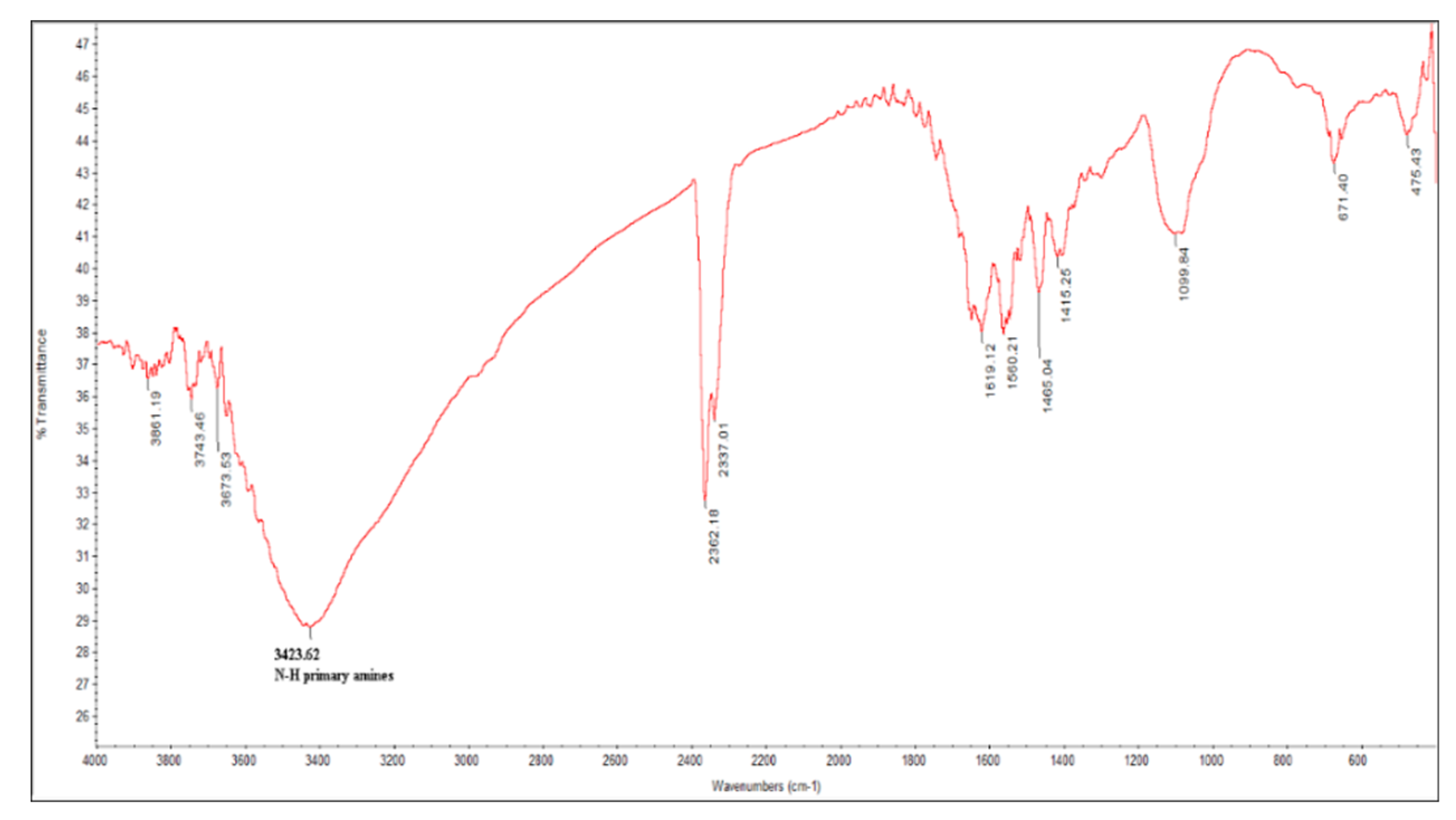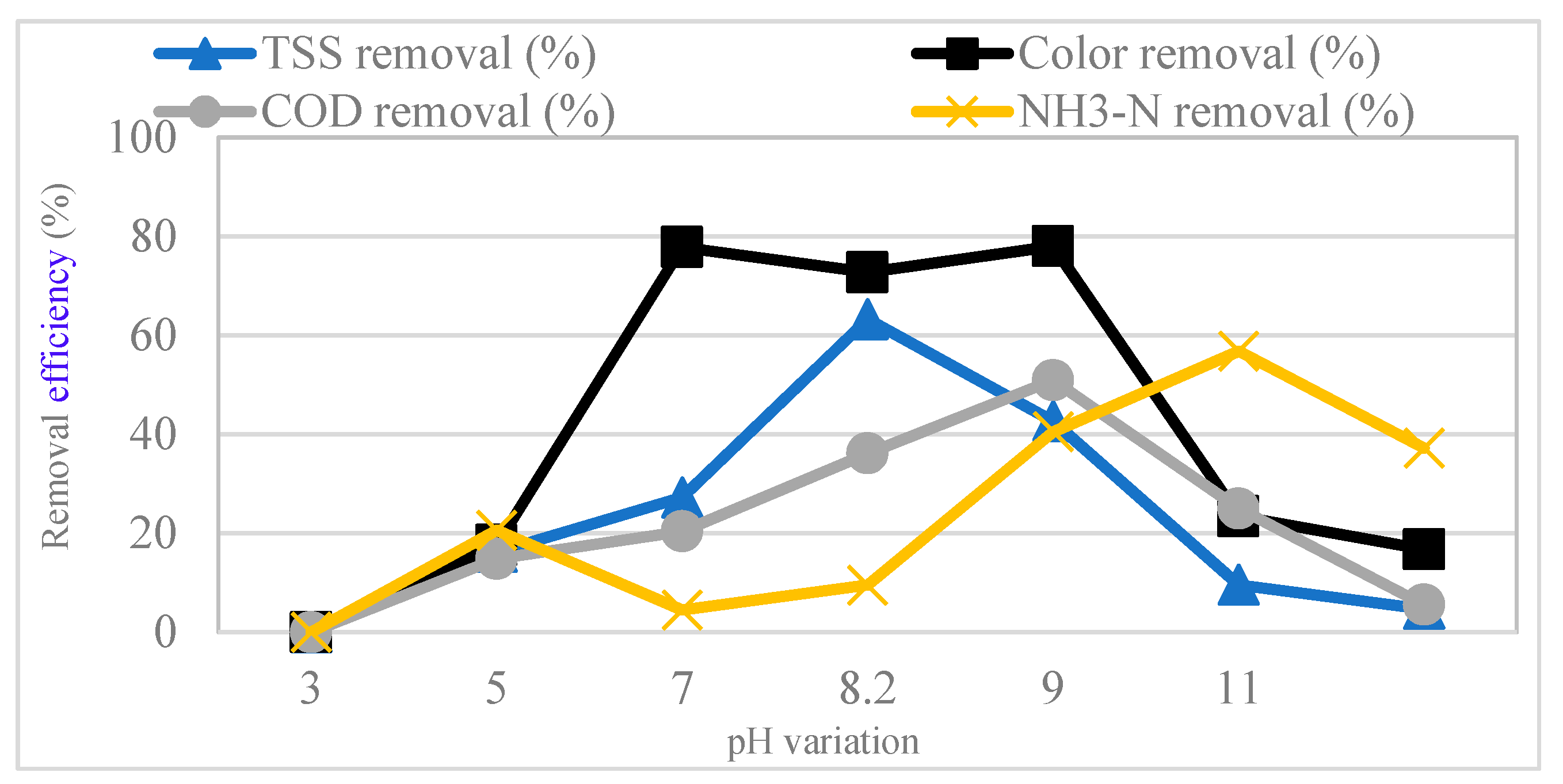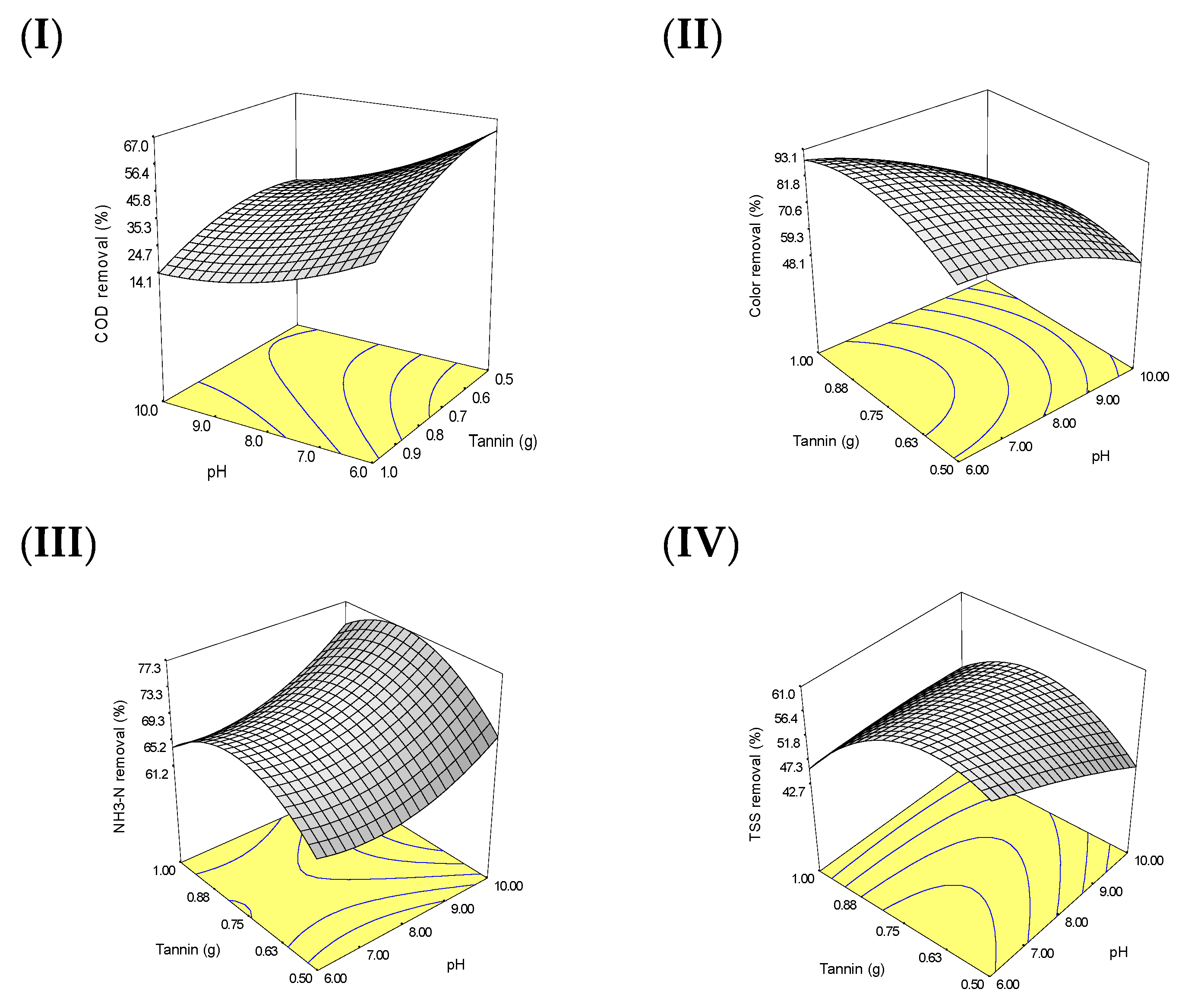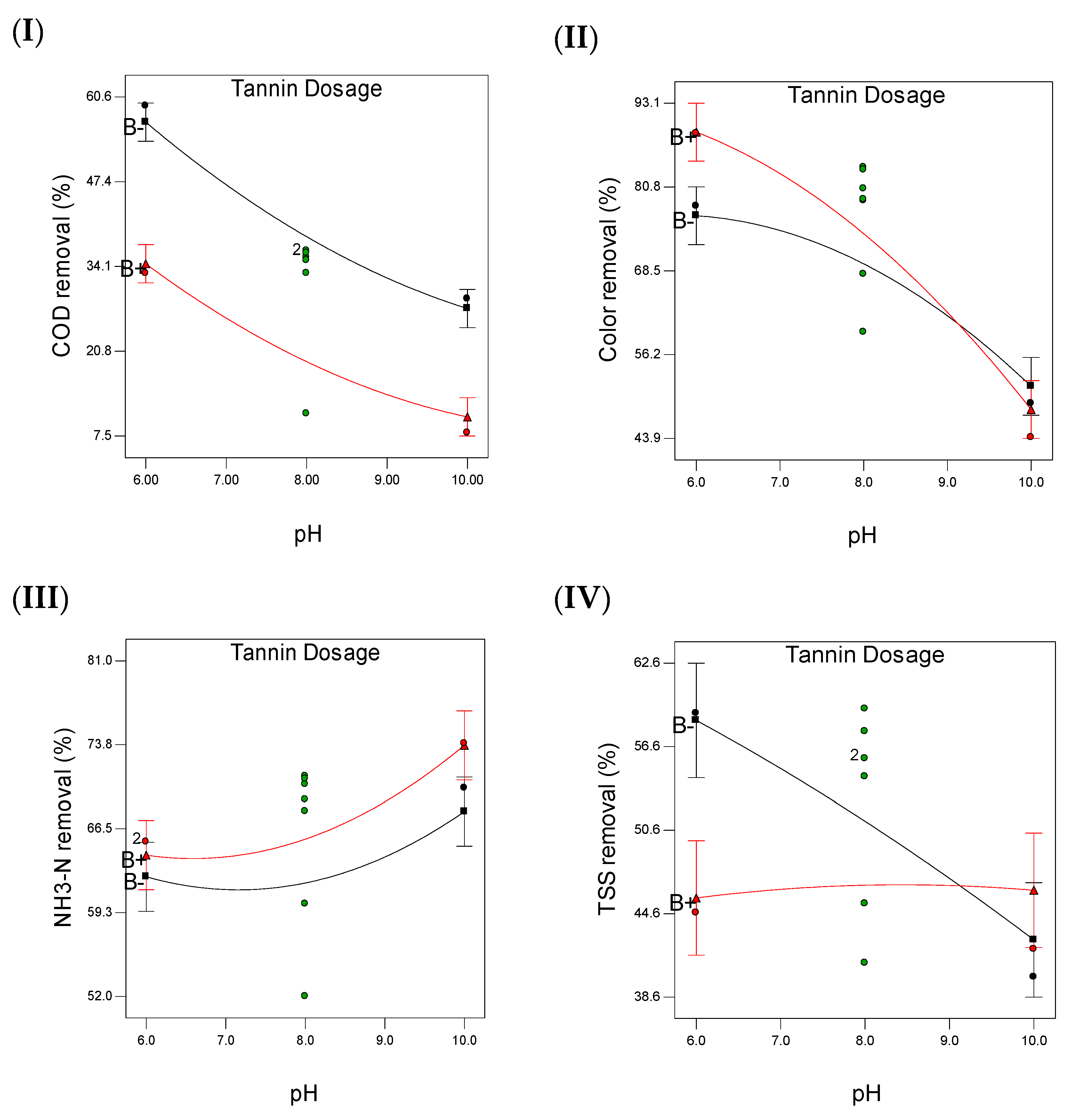Factorial Design and Optimization of Landfill Leachate Treatment Using Tannin-Based Natural Coagulant
Abstract
1. Introduction
2. Methodology
2.1. Sampling and Site Characteristics
2.2. Tannin Characterization
2.3. Experimental Procedure
2.3.1. Effect of Tannin Dosage and pH
2.3.2. Optimization of Treatment Efficiency
2.4. Analytical Study
3. Results and Discussion
3.1. Effect of Tannin
3.2. Effect of pH Variation
3.3. Scanning Electron Microscopy (SEM) Imaging
3.4. Analysis of Variance
3.5. Optimization of Leachate Treatment Using Tannin
3.6. Heavy Metal Removal
4. Conclusions
Author Contributions
Funding
Conflicts of Interest
References
- Ngoc, U.N.; Schnitzer, H. Sustainable solutions for solid waste management in Southeast Asian countries. Waste Manag. 2009, 29, 1982–1995. [Google Scholar] [CrossRef] [PubMed]
- Aziz, H.; Rahim, N.; Ramli, S.; Alazaiza, M.; Omar, F.; Hung, Y.T. Potential Use of Dimocarpus longan Seeds as a Flocculant in Landfill Leachate Treatment. Water 2018, 10, 1672. [Google Scholar] [CrossRef]
- Kebria, D.Y.; Ghavami, M.; Javadi, S.; Goharimanesh, M. Combining an experimental study and ANFIS modeling to predict landfill leachate transport in underlying soil- a case study in north of Iran. Environ. Monit. Assess. 2018, 190, 26. [Google Scholar] [CrossRef] [PubMed]
- Biswas, A.K.; Kumar, S.; Babu, S.S.; Bhattacharyya, J.K.; Chakrabarti, T. Studies on Environmental Quality in and Around Municipal Solid Waste Dumpsite. Res. Conserv. Recycl. 2010, 55, 29–134. [Google Scholar] [CrossRef]
- Alkassasbeh, J.Y.; Heng, L.; Salmijah, S. Toxicity testing and the effect of landfill leachate in Malaysia on behavior of common carp (Cyprinus carpio L., 1758; Pisces, Cyprinidae). Am. J. Environ. Sci. 2009, 5, 209–217. [Google Scholar] [CrossRef]
- Tzoupanos, N.D.; Zouboulis, A.I. Characterization and Application of Novel Coagulant Reagent (Polyaluminium Silicate Chloride) for the Post-Treatment of Landfill Leachates. In Water Treatment Technologies for the Removal of High-Toxicity Pollutants; Springer: Dordrecht, The Netherlands, 2009; pp. 247–252. [Google Scholar]
- Foo, K.Y.; Hameed, B.H. An overview of landfill leachate treatment via activated carbon adsorption process. J. Hazard. Mater. 2009, 171, 54–60. [Google Scholar] [CrossRef]
- Desa, A.; Kadir, N.B.; Yusooff, F. A Study on The Knowledge, Attitudes, Awareness Status and Behaviour Concerning Solid Waste Management. Procedia-Soc. Behav. Sci. 2011, 18, 643–648. [Google Scholar] [CrossRef]
- Manaf, L.A.; Samah, M.A.A.; Zukki, N.I.M. Municipal solid waste management in Malaysia: Practices and challenges. Waste Manag. 2009, 29, 2902–2906. [Google Scholar] [CrossRef]
- Agamuthu, P.; Fauziah, S.H.; Kahlil, K. Evolution of Solid Waste Management in Malaysia: Impacts and Implications of the Solid Waste Bill, 2007. J. Mater. Cycles Waste Manag. 2009, 11, 96–103. [Google Scholar]
- Maslahati, A.; Chelliapan, S.; Wan Mohtar, H.; Kamyab, H. Prediction and Optimization of the Fenton Process for the Treatment of Landfill Leachate Using an Artificial Neural Network. Water 2018, 10, 595. [Google Scholar] [CrossRef]
- Jumaah, M.A.; Othman, M.R.; Yusop, M.R. Characterization of leachate from Jeram sanitary landfill-Malaysia. Int. J. ChemTech Res. 2016, 9, 571–574. [Google Scholar]
- Al-Sabahi, E.; Rahim, S.A.; Wan, Z.; Al-Nozaily, F.; Alshaebi, F. The characteristics of leachate and groundwater pollution at municipal solid waste landfill of Ibb City, Yemen. Am. J. Environ. Sci. 2009, 5, 256–266. [Google Scholar]
- Mussa, Z.H.; Othman, M.R.; Abdullah, M.P. Electrochemical oxidation of landfill leachate: Investigation of operational parameters and kinetics using graphite-PVC composite electrode as anode. J. Braz. Chem. Soc. 2015, 26, 939–948. [Google Scholar] [CrossRef]
- Labanowski, J.; Pallier, V.; Feuillade-Cathalifaud, G. Study of organic matter during coagulation and electrocoagulation processes: Application to a stabilized landfill leachate. J. Hazard. Mater. 2010, 179, 166–172. [Google Scholar] [CrossRef]
- Aziz, H.A.; Othman, O.M.; Abu Amr, S.S. The performance of Electro-Fenton oxidation in the removal of coliform bacteria from landfill leachate. Waste Manag. 2013, 33, 396–400. [Google Scholar] [CrossRef]
- Lak, M.G.; Sabour, M.R.; Amiri, A.; Rabbani, O. Application of quadratic regression model for Fenton treatment of municipal landfill leachate. Waste Manag. 2012, 32, 1895–1902. [Google Scholar]
- Mohajeri, S.; Aziz, H.A.; Isa, M.H.; Zahed, M.A.; Adlan, M.N. Statistical optimization of process parameters for landfill leachate treatment using electro-Fenton technique. J. Hazard. Mater. 2010, 176, 749–758. [Google Scholar] [CrossRef]
- Mohajeri, S.; Aziz, H.A.; Isa, M.H.; Bashir, M.J.K.; Mohajeri, L.; Adlan, M.N. Influence of Fenton reagent oxidation on mineralization and decolourization of municipal landfill leachate. J. Environ. Sci. Health Part A Toxic/Hazard. Subst. Environ. Eng. 2010, 45, 692–698. [Google Scholar] [CrossRef]
- Abu Amr, S.S.; Aziz, H.A.; Adlan, M.N. Optimization of stabilized leachate treatment using ozone/persulfate in the advanced oxidation process. Waste Manag. 2013, 33, 1434–1441. [Google Scholar] [CrossRef]
- Rada, E.; Istrate, I.; Ragazzi, M.; Andreottola, G.; Torretta, V. Analysis of electro-oxidation suitability for landfill leachate treatment through an experimental study. Sustainability 2013, 5, 3960–3975. [Google Scholar] [CrossRef]
- Goi, C.L. A review of marketing mix: 4Ps or More? Int. J. Mark. Stud. 2009, 1, 2. [Google Scholar] [CrossRef]
- Bashir, M.J.K.; Aziz, H.A.; Yusoff, M.S. New sequential treatment for mature landfill leachate by cationic/anionic and anionic/cationic processes: Optimization and comparative study. J. Hazard. Mater. 2011, 186, 92–102. [Google Scholar] [CrossRef]
- Mojiri, A. Review on Membrane Bioreactor, Ion Exchange and adsorption Methods for Landfill Leachate Treatment. Aust. J. Basic Appl. Sci. 2011, 5, 1365–1370. [Google Scholar]
- Graham, N.; Gang, F.; Fowler, G.; Watts, M. Characterisation and coagulation performance of a tannin-based cationic polymer: A preliminary assessment. Colloids Surf. A Physicochem. Eng. Asp. 2008, 327, 9–16. [Google Scholar] [CrossRef]
- Vijayaraghavan, G.; Sivakumar, T.; Kumar, A.V. Application of plant based coagulants for waste water treatment. Int. J. Adv. Eng. Res. Stud. 2011, 1, 88–92. [Google Scholar]
- Mangrich, A.S.; Doumer, M.E.; Mallmann, A.S. Química verde no tratamento de águas: Uso de coagulante derivado de tanino de Acacia mearnsii. Revista Virtual de Química 2014, 6, 2–15. [Google Scholar] [CrossRef]
- Li, H.; Jiao, Y.; Xu, M.; Shi, Z.; He, B. Thermodynamics aspect of tannin sorption on polymeric adsorbents. Polymers 2004, 45, 181–188. [Google Scholar] [CrossRef]
- Sánchez-Martín, J.; Beltrán-Heredia, J.; Solera-Hernández, C. Surface water and wastewater treatment using a new tannin-based coagulant. Pilot plant trials. J. Environ. Manag. 2010, 91, 2051–2058. [Google Scholar] [CrossRef]
- Beltrán-Heredia, J.; Sánchez-Martín, J. Municipal wastewater treatment by modified tannin flocculant agent. Desalination 2009, 249, 353–358. [Google Scholar] [CrossRef]
- Bortolatto, J.F.; Trevisan, T.C.; Bernardi, P.S.I.; Fernandez, E.; Dovigo, L.N.; Loguercio, A.D.; Pretel, H. A novel approach for in-office tooth bleaching with 6% H2O2/TiO_N and LED/laser system—A controlled, triple-blinded, randomized clinical trial. Lasers Med. Sci. 2016, 31, 437–444. [Google Scholar] [CrossRef]
- Mohamed, A.F.; Yaacob, W.W.; Taha, M.R.; Samsudin, A.R. Groundwater and soil vulnerability in the Langat Basin Malaysia. Eur. J. Sci. Res. 2009, 27, 628–635. [Google Scholar]
- Bahaa-eldin, E.A.R.; Wan, Z.W.; Rahim, S.; Ghani, R. Geoenvironmental sampling: How good is a good practice. Geol. Soc. Malays. 2003, 46, 443–446. [Google Scholar]
- Agamuthu, P. Heavy Metal Contamination of Soil-Derived Interstitial Water in The Coastal Regions of Selangor Malaysia. Malays. J. Sci. 2001, 20, 127–134. [Google Scholar]
- Esmail, A.S. Assessment of Groundwater Pollution in The Vicinity of Ampar Tenang Landfill Site. Unpublished. Master’s Thesis, Universiti Kebangsaan Malaysia, Bangi, Malaysia, 2005. [Google Scholar]
- Bahaa, E.E.; Yusoff, I.; Abdul, R.S.; Wan, Z.W.; Ghani, M.R. Deterioration of Groundwater Quality in The Vicinity of an Active Open-Tipping Site in West Malaysia. Hydrogeol. J. 2010, 18, 997–1006. [Google Scholar]
- US Environmental Protection Agency. Effluent Limitations Guidelines, Pretreatment Standards and New Source Performance Standards for the Landfills Point Source Category. 2000. Available online: https://www.federalregister.gov/documents/2000/01/19/00-1037/effluent-limitations-guidelines-pretreatment-standards-and-new-source-performance-standards-for-the (accessed on 10 June 2019).
- Environmental Quality (Control of Pollution from Solid Waste Transfer Station and Landfill) Regulations Malaysia; FAO: Rome, Italy, 2009.
- Oliviero, M.; Stanzione, M.; D’Auria, M.; Sorrentino, L.; Iannace, S.; Verdolotti, L. Vegetable Tannin as a Sustainable UV Stabilizer for Polyurethane Foams. Polymers 2019, 11, 480. [Google Scholar] [CrossRef]
- Roux, D.G.; Ferreira, D.; Hundt, H.K.L.; Malan, E. Structure, stereochemistry, and reactivity of natural condensed tannins as basis for their extended industrial application. J. Appl. Polym. Sci. 1975, 28, 335–353. [Google Scholar]
- Tondi, G. Tannin-Based Copolymer Resins: Synthesis and Characterization by Solid State 13C NMR and FT-IR Spectroscopy. Polymers 2017, 9, 223. [Google Scholar] [CrossRef]
- Arbenz, A.; Avérous, A. Chemical Modification of Tannins to Elaborate Aromatic Biobased Macromolecular Architectures. Green Chem. 2015, 17, 2626–2646. [Google Scholar] [CrossRef]
- Matamala, G.; Smeltzer, W.; Droguett, G. Comparison of steel anticorrosive protection formulated with natural tannins extracted from acacia and from pine bark. Corros. Sci. 2000, 42, 1351–1362. [Google Scholar] [CrossRef]
- Ghaffari, A.; Miller, C.C.; McMullin, B.; Ghahary, A. Potential application of gaseous nitric oxide as a topical antimicrobial agent. Nitric Oxide 2006, 14, 21–29. [Google Scholar] [CrossRef]
- American Public Health Association. Standard Methods for the Examination of Water and Wastewater APHA, 21st ed.; American Public Health Association (APHA): Washington, DC, USA, 2005. [Google Scholar]
- Palma, G.; Freer, J.; Baeza, J. Removal of metal ions by modified Pinus radiata bark and tannins from water solutions. Water Res. 2003, 37, 4974–4980. [Google Scholar] [CrossRef]
- Schofield, P.; Mbugua, D.M.; Pell, A.N. Review: Analysis of condensed tannins: A review. Anim. Feed Sci. Technol. 2001, 91, 21–40. [Google Scholar] [CrossRef]
- Kim, T.J.; Silva, J.L.; Kim, M.K.; Jung, Y.S. Enhanced antioxidant capacity and antimicrobial activity of tannic acid by thermal processing. Food Chem. 2010, 118, 740–746. [Google Scholar] [CrossRef]
- Xia, T.; Kovochich, M.; Liong, M.; Mädler, L.; Gilbert, B.; Shi, H.; Nel, A.E. Comparison of the mechanism of toxicity of zinc oxide and cerium oxide nanoparticles based on dissolution and oxidative stress properties. ACS Nano 2008, 2, 2121–2134. [Google Scholar] [CrossRef]
- Zhang, B.; Su, H.; Gu, X.; Huang, X.; Wang, H. Effect of structure and charge of polysaccharide flocculants on their flocculation performance for bentonite suspensions. Colloids Surf. A Physicochem. Eng. Asp. 2013, 436, 443–449. [Google Scholar] [CrossRef]
- Okaiyeto, K.; Nwodo, U.; Mabinya, L.; Okoh, A. Characterization of a bioflocculant produced by a consortium of Halomonas sp. Okoh and Micrococcus sp. Leo. Int. J. Environ. Res. Public Health 2013, 10, 5097–5110. [Google Scholar] [CrossRef]
- Wang, L.; Feng, Z.; Wang, X.; Wang, X.; Zhang, X. DEGseq: An R package for identifying differentially expressed genes from RNA-seq data. Bioinformatics 2011, 26, 136–138. [Google Scholar] [CrossRef]
- Zhang, D.; Hou, Z.; Liu, Z.; Wang, T. Experimental research on Phanerochaete chrysosporium as coal microbial flocculant. Int. J. Min. Sci. Technol. 2013, 23, 521–524. [Google Scholar] [CrossRef]
- Cosa, S.; Ugbenyen, A.M.; Mabinya, L.V.; Rumbold, K.; Okoh, A.I. Characterization and flocculation efficiency of a bioflocculant produced by a marine Halobacillus. Environ. Technol. 2013, 34, 2671–2679. [Google Scholar] [CrossRef]
- Nwodo, U.U.; Okoh, A.I. Characterization and flocculation properties of biopolymeric flocculant (glycosaminoglycan) produced by Cellulomonas sp. O koh. J. Appl. Microbiol. 2013, 114, 1325–1337. [Google Scholar] [CrossRef]
- Salehizadeh, H.; Shojaosadati, S.A. Extracellular biopolymeric flocculants: Recent trends and biotechnological importance. Biotechnol. Adv. 2001, 19, 371–385. [Google Scholar] [CrossRef]
- He, N.; Li, Y.; Chen, J.; Lun, S.Y. Identification of a novel bioflocculant from a newly isolated Corynebacterium glutamicum. Biochem. Eng. J. 2002, 11, 137–148. [Google Scholar] [CrossRef]
- Lian, B.; Chen, Y.; Zhao, J.; Teng, H.H.; Zhu, L.; Yuan, S. Microbial flocculation by Bacillus mucilaginosus: Applications and mechanisms. Bioresour. Technol. 2008, 99, 4825–4831. [Google Scholar] [CrossRef]
- Slabbert, N. Complexation of Condensed Tannins with Metal Ions. In Plant Polyphenols. Basic Life Sciences; Hemingway, R.W., Laks, P.E., Eds.; Springer: Boston, MA, USA, 1992; Volume 59, pp. 421–436. [Google Scholar]
- Ashraf, M.A.; Balkhair, K.S.; Chowdhury, A.J.K.; Hanafiah, M.M. Treatment of Taman Beringin landfill leachate using the column technique. Desalin. Water Treat. 2019, 149, 370–387. [Google Scholar] [CrossRef]
- Basheer, A.O.; Hanafiah, M.M.; Alsaadi, M.A.; Douri, Y.A.; Aljumaily, M.M.; Fiyadh, S.S. Synthesis and characterization of natural extracted precursor date palm fibre-based activated carbon for aluminum removal by RSM optimization. Processes 2019, 7, 249. [Google Scholar] [CrossRef]
- Hanafiah, M.M.; Hashim, N.A.; Ahmed, S.T.; Ashraf, M.A. Removal of chromium from aqueous solutions using a palm kernel shell adsorbent. Desalin. Water Treat. 2018, 118, 172–180. [Google Scholar] [CrossRef]
- Manikam, M.K.; Halim, A.A.; Hanafiah, M.M.; Krishnamoorthy, R.R. Removal of ammonia nitrogen, nitrate, phosphorus and COD from sewage wastewater using palm oil boiler ash composite adsorbent. Desalin. Water Treat. 2019, 149, 23–30. [Google Scholar] [CrossRef]
- Rajesh Kumar, P.R.; Akila Swathanthra, P.A.; Basava Rao, V.V.B.; Rao, S.R.M. Adsorption of Cadmium and Zinc Ions from Aqueous Solution Using Low Cost Adsorbents. J. Appl. Sci. 2014, 14, 1372–1378. [Google Scholar]
- Tondi, G.; Oo, C.W.; Pizzi, A.; Trosa, A.; Thevenon, M.F. Metal adsorption of tannin-based rigid foams. Ind. Crops Prod. 2009, 29, 336–340. [Google Scholar] [CrossRef]
- Oo, C.W.; Kassim, M.J.; Pizzi, A. Characterization and performance of Rhizophora apiculata mangrove polyflavonoid tannins in the adsorption of copper (II) and lead (II). Ind. Crops Prod. 2009, 30, 152–161. [Google Scholar] [CrossRef]







| Parameter | Mean and Standard Deviation | (USEPA [37]; DOE [38]) |
|---|---|---|
| pH | 7.9 ± 0.5 | 6–9 ** |
| EC (µS/cm) | 6565 ± 324 | - |
| TDS (mg/L) | 4671 ± 174 | - |
| TSS (mg/L) | 40 ± 8 | 88 * |
| COD (mg/L) | 893 ± 202 | 400 ** |
| BOD5 (mg/L) | 59 ± 10 | 20 ** |
| NH3–H (mg/L) | 531 ± 22 | 5 ** |
| DO (mg/L) | 5 ± 2 | 10 * |
| Mg (mg/L) | 20 ± 4 | - |
| Ca (mg/L) | 40 ± 3 | - |
| Na (mg/L) | 639 ± 303 | - |
| Fe (mg/L) | 0.8 ± 0.2 | 5 ** |
| Zn (µg/L) | 280 ± 2 | 2000 ** |
| Cu (µg/L) | 42 ± 4 | 20 ** |
| Cr (µg/L) | 45 ± 2 | 10 ** |
| Cd (µg/L) | 0.6 ± 0.1 | 10 ** |
| Pb (µg/L) | 4 ± 1 | 10 ** |
| As (µg/L) | 17 ± 7 | 50 ** |
| Co (µg/L) | 11 ± 8 | 50 ** |
| Mn (µg/L) | 61 ± 49 | 20 ** |
| Level of Value | Tannin Dosage (g) | pH | ||||
|---|---|---|---|---|---|---|
| Tannin | pH | Coded | Actual | Coded | Actual | Coded |
| 0.4 | 5.17 | −1.414 | 0.5 | −1 | 6 | −1 |
| 0 | 0.75 | 0 | 8 | 0 | ||
| 1.1 | 10.83 | +1.414 | 1 | 1 | 10 | 1 |
| Run No. | Point Type | Factor 1: pH | Factor 2: Tannin (g) | COD Removal (%) | Color Removal (%) | NH3–N Removal (%) | Total Suspended Solids (TSS) Removal (%) | ||||||||
|---|---|---|---|---|---|---|---|---|---|---|---|---|---|---|---|
| Actual | Predicted | Residual | Actual | Predicted | Residual | Actual | Predicted | Residual | Actual | Predicted | Residual | ||||
| 1 | Axial | 5.17 | 0.75 | 67.00 | 66.90 | 0.10 | 92.00 | 93.43 | −1.43 | 68.90 | 71.20 | −2.29 | 60.26 | 60.64 | −0.38 |
| 2 | Axial | 10.83 | 0.75 | 28.00 | 27.60 | 0.40 | 51.00 | 46.87 | 4.13 | 81.00 | 81.88 | −0.88 | 54.00 | 49.88 | 4.12 |
| 3 | Center | 8.00 | 0.75 | 37.50 | 36.34 | 1.16 | 78.81 | 81.09 | −2.27 | 70.32 | 69.83 | 0.49 | 55.70 | 56.55 | −0.85 |
| 4 | Axial | 8.00 | 0.40 | 34.00 | 37.69 | −3.69 | 59.49 | 59.26 | 0.23 | 52.00 | 54.91 | −2.91 | 45.28 | 44.52 | 0.76 |
| 5 | Center | 8.00 | 0.75 | 36.80 | 36.34 | 0.46 | 83.70 | 81.09 | 2.62 | 71.02 | 69.83 | 1.20 | 55.70 | 56.55 | −0.85 |
| 6 | Fact | 10.00 | 0.50 | 31.00 | 28.57 | 2.43 | 49.00 | 51.52 | −2.52 | 70.00 | 67.98 | 2.02 | 40.00 | 42.67 | −2.67 |
| 7 | Center | 8.00 | 0.75 | 36.17 | 36.34 | −0.16 | 79.00 | 81.09 | −2.09 | 70.79 | 69.83 | 0.96 | 54.40 | 56.55 | −2.15 |
| 8 | Fact | 6.00 | 1.00 | 33.00 | 35.93 | −2.93 | 88.71 | 88.88 | −0.17 | 65.37 | 64.22 | 1.15 | 44.63 | 45.69 | −1.06 |
| 9 | Fact | 10.00 | 1.00 | 11.00 | 14.14 | −3.14 | 44.00 | 48.10 | −4.10 | 73.85 | 73.70 | 0.15 | 42.00 | 46.25 | −4.25 |
| 10 | Axial | 8.00 | 1.10 | 13.00 | 8.81 | 4.19 | 68.00 | 65.53 | 2.47 | 60.00 | 60.27 | −0.27 | 41.00 | 38.02 | 2.98 |
| 11 | Fact | 6.00 | 0.50 | 65.00 | 62.36 | 2.64 | 78.00 | 76.59 | 1.41 | 65.37 | 62.35 | 3.02 | 58.96 | 58.45 | 0.51 |
| 12 | Center | 8.00 | 0.75 | 35.04 | 36.34 | −1.30 | 83.35 | 81.09 | 2.27 | 69.00 | 69.83 | −0.83 | 59.28 | 56.55 | 2.74 |
| 13 | Center | 8.00 | 0.75 | 36.17 | 36.34 | −0.16 | 80.56 | 81.09 | −0.53 | 68.00 | 69.83 | −1.83 | 57.65 | 56.55 | 1.11 |
| Source | Sum of Squares | DF | Mean Square | F Value | Prob > F | |
| COD Removal (%) | Model | 2650.63 | 5 | 530.13 | 103.36 | <0.0001 |
| A | 1414.38 | 1 | 1414.38 | 275.77 | <0.0001 | |
| B | 767.20 | 1 | 767.20 | 149.59 | <0.0001 | |
| A2 | 77.79 | 1 | 77.79 | 15.17 | 0.0059 | |
| B2 | 334.50 | 1 | 334.50 | 65.22 | <0.0001 | |
| AB | 6.81 | 1 | 6.81 | 1.33 | 0.2870 | |
| Residual | 35.90 | 7 | 5.13 | |||
| Lack of Fit | 34.46 | 3 | 11.49 | 31.87 | 0.0030 | |
| Pure Error | 1.44 | 4 | 0.36 | |||
| Cor Total | 2686.53 | 12 | ||||
| Std. Dev: 2.26, R2: 0.9866, Mean: 33.67; Adj R2: 0.9771, C.V: 6.73; Pred R2: 0.9079; Adeq Precision: 34.585 | ||||||
| Color Removal (%) | Source | Sum of Squares | DF | Mean Square | F Value | Prob > F |
| Model | 3003.96 | 5 | 600.79 | 58.23 | <0.0001 | |
| A | 2167.80 | 1 | 2167.80 | 210.10 | <0.0001 | |
| B | 39.36 | 1 | 39.36 | 3.82 | 0.0917 | |
| A2 | 207.87 | 1 | 207.87 | 20.15 | 0.0028 | |
| B2 | 607.43 | 1 | 607.43 | 58.87 | 0.0001 | |
| AB | 61.68 | 1 | 61.68 | 5.98 | 0.0444 | |
| Residual | 72.22 | 7 | 10.32 | |||
| Lack of Fit | 50.44 | 3 | 16.81 | 3.09 | 0.1523 | |
| Pure Error | 21.78 | 4 | 5.44 | |||
| Cor Total | 3076.18 | 12 | ||||
| Std. Dev.: 3.21, R2: 0.9765, Mean: 71.97, Adj R2:0.9598, C.V.:4.46 Pred R2:0.8723, Adeq Precision: 21.336 | ||||||
| Source | Sum of Squares | DF | Mean Square | F Value | Prob > F | |
| NH3–N Removal (%) | Model | 529.27 | 5 | 105.85 | 20.75 | 0.0005 |
| A | 114.12 | 1 | 114.12 | 22.37 | 0.0021 | |
| B | 28.75 | 1 | 28.75 | 5.64 | 0.0493 | |
| A2 | 78.35 | 1 | 78.35 | 15.36 | 0.0058 | |
| B2 | 260.56 | 1 | 260.56 | 51.08 | 0.0002 | |
| AB | 3.71 | 1 | 3.71 | 0.73 | 0.4220 | |
| Residual | 35.71 | 7 | 5.10 | |||
| Lack of Fit | 29.08 | 3 | 9.69 | 5.85 | 0.0604 | |
| Pure Error | 6.62 | 4 | 1.66 | |||
| Cor Total | 564.98 | 12 | ||||
| Std. Dev.: 2.26, R2: 0.9368: Mean: 68.13, Adj R2: 0.8917, C.V.: 3.32: Pred R2: 0.6156, Adeq Precision: 17.580 | ||||||
| TSS Removal (%) | Source | Sum of Squares | DF | Mean Square | F Value | Prob > F |
| Model | 631.55 | 5 | 126.31 | 13.02 | 0.0020 | |
| A | 115.80 | 1 | 115.80 | 11.94 | 0.0106 | |
| B | 42.23 | 1 | 42.23 | 4.35 | 0.0754 | |
| A2 | 2.88 | 1 | 2.88 | 0.30 | 0.6030 | |
| B2 | 405.95 | 1 | 405.95 | 41.84 | 0.0003 | |
| AB | 66.69 | 1 | 66.69 | 6.87 | 0.0343 | |
| Residual | 67.91 | 7 | 9.70 | |||
| Lack of Fit | 53.14 | 3 | 17.71 | 4.80 | 0.0820 | |
| Pure Error | 14.77 | 4 | 3.69 | |||
| Cor Total | 699.46 | 12 | ||||
| Std. Dev.: 3.11, R2: 0.9029, Mean: 51.45, Adj R2: 0.8336, C.V.: 6.05, Pred R2: 0.4267, Adeq Precision:10.690 | ||||||
| pH | Tannin Dosage (g) | TSS Removal (%) | Color Removal (%) | COD Removal (%) | NH3–N Removal (%) | Desirability |
|---|---|---|---|---|---|---|
| 6.00 | 0.73 | 60.3 | 91.3882 | 53.5 | 69.7 | 0.844 |
| Lab experiment | 60.7 | 90.7 | 52.8 | 66.3 | ||
| Heavy Metals | Initial Concentration in Leachate | Residual After Tannin Coagulation | Removal (%) |
|---|---|---|---|
| Fe (mg/L) | 0.8 ± 0.2 | 0.1 ± 0.0 | 89 ± 2 |
| Zn (µg/L) | 280 ± 2 | 15 ± 1 | 94 ± 3 |
| Cu (µg/L) | 42 ± 4 | 2.5 ± 0.3 | 94 ± 2 |
| Cr (µg/L) | 45 ± 2 | 5 ± 1 | 90 ± 1 |
| Cd (µg/L) | 0.6 ± 0.1 | 0.5 ± 0.1 | 17 ± 1 |
| Pb (µg/L) | 4 ± 1 | 0.3 ± 0.0 | 94 ± 2 |
| As (µg/L) | 17 ± 7 | 2.4 ± 1 | 86 ± 1 |
| Co (µg/L) | 11 ± 8 | 1.7 ± 0.5 | 84 ± 2 |
© 2019 by the authors. Licensee MDPI, Basel, Switzerland. This article is an open access article distributed under the terms and conditions of the Creative Commons Attribution (CC BY) license (http://creativecommons.org/licenses/by/4.0/).
Share and Cite
Banch, T.J.H.; Hanafiah, M.M.; Alkarkhi, A.F.M.; Abu Amr, S.S. Factorial Design and Optimization of Landfill Leachate Treatment Using Tannin-Based Natural Coagulant. Polymers 2019, 11, 1349. https://doi.org/10.3390/polym11081349
Banch TJH, Hanafiah MM, Alkarkhi AFM, Abu Amr SS. Factorial Design and Optimization of Landfill Leachate Treatment Using Tannin-Based Natural Coagulant. Polymers. 2019; 11(8):1349. https://doi.org/10.3390/polym11081349
Chicago/Turabian StyleBanch, Tawfiq J. H., Marlia M. Hanafiah, Abbas F. M. Alkarkhi, and Salem S. Abu Amr. 2019. "Factorial Design and Optimization of Landfill Leachate Treatment Using Tannin-Based Natural Coagulant" Polymers 11, no. 8: 1349. https://doi.org/10.3390/polym11081349
APA StyleBanch, T. J. H., Hanafiah, M. M., Alkarkhi, A. F. M., & Abu Amr, S. S. (2019). Factorial Design and Optimization of Landfill Leachate Treatment Using Tannin-Based Natural Coagulant. Polymers, 11(8), 1349. https://doi.org/10.3390/polym11081349






